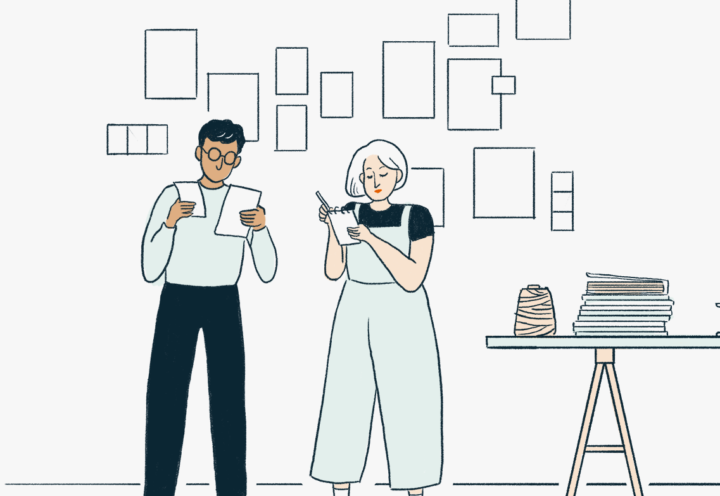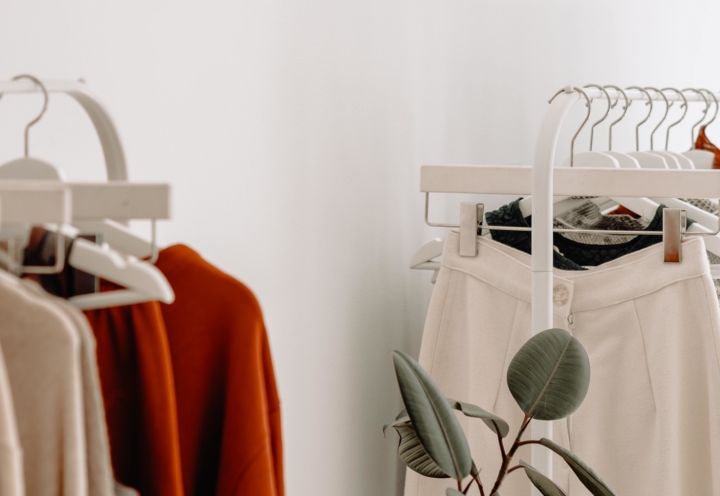In Conversation With Kresse Wesling, Co-Founder of Elvis & Kresse
6 min Mar 19
Photography provided by Elvis & Kresse
SupplyCompass recently spoke to Kresse Wesling MBE, Co-Founder of Elvis & Kresse, the sustainable luxury brand and B Corp converting industrial and commercial waste, such as fire hoses and coffee bags, into luxury goods and accessories.
In Conversation With is SupplyCompass’ interview series, highlighting fashion businesses from around the globe who are balancing people, profit and planet, and are leading the way when it comes to responsible business.
Elvis & Kresse was launched to solve the problem of London’s decommissioned fire hoses. Since 2005 they have been collecting all of London’s hoses, transforming them into high quality, hand-crafted lifestyle accessories and donating 50% of the profits from this collection to the Fire Fighters Charity.
Elvis & Kresse have also turned their attention to tackling the waste created in the production of leather goods, supported with a grant from the Burberry Foundation. They have expanded to repurpose more than 12 materials that would have otherwise gone to landfill, and are pioneering research that will change how aluminium is recycled, which could have impacts far beyond the fashion industry.

Tell us a bit more about Elvis & Kresse? What prompted you to start the brand?
Elvis & Kresse didn’t start with the intent of becoming a brand, it started from an interest in waste. When I first came to the UK in 2004, my interest in waste led me to the sewers and the Battersea Waste Transfer Station, where there were mountains of materials being sorted before being taken to other places, and there was a lot of material that I didn’t expect to see.
Then, I went to the British Library—this was back before you could find Office for National Statistics data and not everything was on Google—and started trying to understand the British waste situation. Although I could get bulk numbers, which were terrifying—e.g. in 2004, 100 million tonnes of material went to landfill—I couldn’t get any real breakdown.
What really annoyed me, in many ways, was a lot of waste that didn’t need to be there. A lot of it was commercial and industrial. There were a lot of materials that were clean, unused, off-cuts of something or a byproduct of something else, and it was coming in constant flows. I started making notes about what these flows were – I even made friends with a lot of truck drivers and traced the materials back to their source. My next set of pilgrimages was to industrial sites all over the country to see where these materials came from and why they were being thrown away in the first place.
What I discovered was that we have a very low landfill tax in the UK, so it’s very easy to get rid of waste, especially if it’s lightweight. We lacked a lot of creativity and we weren’t applying ourselves to these materials and we weren’t treasuring them. It was at this point that I discovered that fire hoses were a problem. I went to meet the Fire Brigade and found out that every year between 3 and 10 tonnes of fire hose goes to landfill because it either reaches the end of its health and safety life, or it becomes too damaged for the fire safety to repair.
I thought – this is where I can put all of my energy and creativity and prove that waste doesn’t have to be wasted. So, we didn’t set out to start Elvis & Kresse in any way, we set out to save London’s fire hoses from going to landfill.
What do the opportunities in waste mean for the fashion industry?
For the fashion industry, it means it’s time to have a complete systemic change. At last year’s Copenhagen Fashion Summit, The Union of Concerned Researchers in Fashion released data that showed that despite announcements and initiatives around sustainability over the last 10 years, none of the sustainability initiatives are really having an impact and they are inconsequential. That means that the industry has been really good at talking itself up for the last 10 years, but it has been delivering mediocre results. To be honest, none of it is worth celebrating, yet. You might have initiatives like ours that are small, but they are not scaled.
When you have companies with £4 billion of unsold stock, or customers buying clothes they never wear or only wear once, then we have a systemic problem. We’ve got a manufacturing problem, a business problem, a creation problem, and a cultural problem. All of that has to change.
What makes Elvis & Kresse unique?
We look at absolutely everything that we do. It isn’t enough for us to be rescuing firehose or leather. It isn’t enough to give 50% profits to charity. We don’t do seasonal collections. We don’t design based on trends. We reinterpret classic pieces and shapes that will get used season after season. We are a living wage business, and we are completely vertically integrated – this means that we manufacture our own products. We use renewable energy. We were one of the first B Corps in the UK. We think shareholders are not more important than the planet and its people. We make our own packaging and business cards from waste. There is no end to which we won’t go to create the best business that can exist; that means we have to go pretty far.
Tell us more about the leather used for Elvis & Kresse accessories?
We started looking at leather waste in 2010, as by then our business was large enough to be contributing to solving the fire hose problem. Leather is different as it’s multipurpose and it’s used across different industries. The UN had a report about how there was around 800,000 tonnes of waste in 2010, although a lot of companies don’t report on their waste, so this is a very low estimate.
We wanted to design a system that could give a new purpose for these small scraps. Once leather is tanned, it’s not going to biodegrade, so we came up with this leather system and we started making bags, rugs and upholstery. Burberry approached us and in 2017 we formed a partnership with the Burberry Foundation to scale our leather system, rescue Burberry leather, and really show the world that industrial offcuts had enormous value. 50% of the profits from this project go to create scholarships for Barefoot College, which power scholarships for female solar engineers – so far we have created 9 scholarships.
Because of the climate crisis, we need to move incredibly quickly on our initiatives. We know that the next decade is all about impact. Wherever an offcut is produced, the system we have produced for leather will work for leather alternatives, too. Firehose isn’t leather; it’s a waste material that would otherwise go to landfill. We focus on using the materials that already exist in the world as a primary source.
Tell us a bit more about your customers? How did you build a community around your brand and how do you grow it?
We know that we have three different communities: firstly, the Fire Service and their families, friends and supporters, not only in the UK but also across the world. Secondly, we have the conscious consumer. They are interested in organic food, more sustainable products and many of them are also interested in vegan products. Thirdly, we have the design-focused customer who likes our aesthetic and that our items are built to last and can be used year in, year out. The special thing about our products is that each one is unique; when you are using rescued materials, no two pieces will ever be the same.
60% of our customers are in the UK, and we are shipping orders internationally every single week. All of our sales come via online channels, as we don’t have physical stores. We’ve always focused on a digital strategy; we started in 2005 and we had an e-commerce website before Net-a-Porter. We built our first website on Dreamweaver as Squarespace and Shopify had yet to be invented. Elvis learnt to code and we built a website from scratch, and our first website was so simple, but we only sold four types of belts at the time. Digital has always been core to our business strategy.
Department stores and a lot of retailers demand change; what is happening for fall 2021, and what new colours are coming up, etc. 90% of fire hoses are red, so we’re never going to play that game. It’s much better for us to have a direct to customer relationship than be reliant on go-between.
Additionally, our commitment to B Corp is very strong, and that’s because we think the world needs to change, and we want to show them how much fun we’re having and how amazing it is to work in this way.
What are your aspirations for the future of Elvis & Kresse?
We are always innovating, but something we’re focusing on now is making our own hardware. We know we can only do that if we can do it in an Elvis & Kresse way, which means it has to be made from waste material and we have to be solving a waste problem. We also have to do it in a future-forward way, for us that means using renewable energy.
We looked into the idea of collecting aluminium cans and micro forging them into our own buckles and d-rings. There are 16 million aluminium cans that get littered into British public spaces each year. If you add aluminium cans and plastic bottles littered, this results in the death of 3 million small mammals because they are getting stuck in the cans and drink containers and are unable to escape. It’s not just a litter problem, it’s also a huge issue for biodiversity loss. It’s absolutely appalling.
In a recent study, Keep Britain Tidy estimated that 2.9 million small mammals—like shrews, hedgehogs and voles—are dying each year after getting stuck in bottles and cans thrown onto grassland and parks.
Plus, we also have the 2 billion aluminium cans that go in the bin because people don’t necessarily put them in the recycling bin. When you recycle aluminium as opposed to mining new aluminium it uses 95% less energy. We really have to ensure a better future.
When looking into this further, we discovered that a renewable energy powered micro forge did not exist. We got together with the Queen Mary University of London and we formed a project to open source the design and output of this. Over the next 12 months, we will be collaborating with engineers in universities and experts globally. Once we have this machine, the fact that it’s going to be open source means everyone in the world can use it and benefit from it.
What has been your biggest learning along the way?
You’re never done learning. You will never understand everything about how the world works. Running a business is so fun and interesting, so as long as you’re curious, there’s a never-ending list of challenges to face. The biggest learning is that we’re never, ever done.
What’s your advice about sustainability to other brands?
For those who are right at the beginning of your journey, you have to ask yourself what is morally correct or not. We’ve never had food so cheaply in the history of civilization, and we’ve never had fashion as cheap either. The problems associated with that is that we are constantly putting pressure on supply chains that force environmental degradation and human exploitation.
We don’t just have modern slavery in Bangladesh, there is modern slavery in the UK. We don’t just have environmental degradation at the leather dying pools in Pakistan, we have that kind of issue in Europe, too. Fashion is being subsidised by the environment and by people that are being exploited. It has to have a price, and the price is not the price of most of the British high street. I cannot say that more blatantly enough. If brands want to play that game, then they are making the wrong moral choice from the beginning, and that’s a mistake.
If you are starting a business from scratch now and it has no hope of becoming a Social Enterprise, a B Corp or regenerative, then you should stop your plans and think again. You still have time to do the right thing.
Highlighting fashion and homeware brands from around the globe who are balancing people, profit and planet.
Gus is CEO of SupplyCompass. He is responsible for driving sustainable growth across the business. He believes that the best route to creating seismic change within the global fashion manufacturing industry is to find virtuous loops that drive improvements for people, planet and profit.
More on our blog
4 ways our Moodboard tool can save you time, money and improve quality!
Our moodboard feature isn’t a moodboard as you know it. You can use it not just as a collaborative inspiration sharing tool, but also as a sourcing pack with your factory, for sharing and commenting on quality assurance images, and to gather and share customer feedback with your factory!
2 min
5 Top Tips to make your product lines more profitable
As a brand, you want to deliver your customers the best quality product at an affordable price point, yet you also need to make sure it can be a profitable line for your business. Products need to fall into a specific RRP price point, so finding ways to maximise your margin needs to come from the design. Here we look at 5 top tips to help you maximise your profitability.
5 min
We’ve just launched some snazzy new features
After some major product feature launches in Jan, we’ve been busy since making lots of small, but important updates. Here’s a round-up of our 6 hottest new features released in the last month
5 min
Get started with our platform
Let’s stay
in touch!
Everything you need to know about sustainable supply chains, including industry news and product updates, delivered straight to your inbox.









